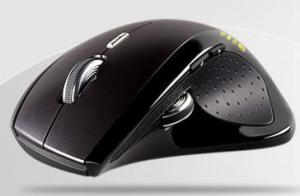I’m sure you are all familiar with the Ralph Waldo Emerson quote, “Build a better mousetrap and the world will beat a path to your door.” There is even a book by Graham Barker & Peter Bissell called A Better Mousetrap: the business of invention.
 However, as a computer addict for over 30 years (anyone remember the Commodore Pet) I have suffered from repetitive strain injury (RSI) for many years. The introduction of the mouse in the 1980s only made matters worse for me. Consequently I have spent much time investigating new and improved hardware and software.
However, as a computer addict for over 30 years (anyone remember the Commodore Pet) I have suffered from repetitive strain injury (RSI) for many years. The introduction of the mouse in the 1980s only made matters worse for me. Consequently I have spent much time investigating new and improved hardware and software.
For over 10 years I have been using my left hand for mousing at work and my right at home to spread the strain. When the pain was at its worst I experimented with auto-mouse-click software. (When the mouse pointer stops moving, the system counts down a fixed interval and triggers a mouse click.) However this was very tricky to use, especially for moving items around the screen.
 A more successful approach has been to upgrade my mouse, first from the type relying on a physical ball for positioning, to infra-red, and more recently to laser powered. Also the introduction of a scroll wheel significantly improved the ergonomic experience, especially for those long hours surfing the web for information.
A more successful approach has been to upgrade my mouse, first from the type relying on a physical ball for positioning, to infra-red, and more recently to laser powered. Also the introduction of a scroll wheel significantly improved the ergonomic experience, especially for those long hours surfing the web for information.
I briefly experimented with a track-ball mouse but couldn’t get on with it.
However a couple of years ago I saw the the answer to my prayers (and started saving the £70 required to acquire it). This particular example is from Logitech (although I’m sure there are similar ones available now). The key factors are its ergonomic shape, which comfortably fits into my hand, a high precision laser beam leading to less hesitation on the screen, and a wireless USB connection preventing snagged cables. It also has a scroll wheel with a needle roller bearing (something of an engineering anachronism in these days of high-tech). When the wheel is set to ‘free scroll’ (my default setting), I can whiz up and down fifty screens worth of information with one gentle flick of my finger.
I understand that thought controlled computer interfaces are being developed, but until that day I think I will be happy with my digital mouse.











 However, as a computer addict for over 30 years (anyone remember the
However, as a computer addict for over 30 years (anyone remember the  A more successful approach has been to upgrade my mouse, first from the type relying on a physical ball for positioning, to infra-red, and more recently to laser powered. Also the introduction of a scroll wheel significantly improved the ergonomic experience, especially for those long hours surfing the web for information.
A more successful approach has been to upgrade my mouse, first from the type relying on a physical ball for positioning, to infra-red, and more recently to laser powered. Also the introduction of a scroll wheel significantly improved the ergonomic experience, especially for those long hours surfing the web for information.

